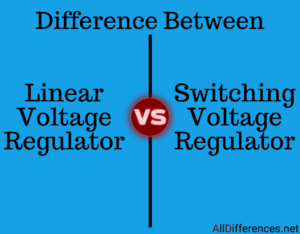Comparison between Linear and Switching voltage regulator
Contents
- The Key Difference between Linear and Switching voltage regulator are below the table.

Comparison Chart
| Linear voltage regulator | Switching voltage regulator | |
|---|---|---|
| Power loss | The Series-Pass transistor operates in active region. Hence, there is high power loss. | Switching device operates in either cut-off or saturation region. So losses are less. |
| Efficiency | Due to high power loss efficiency is less | Due to high power loss efficiency is less |
| Power handling capability | Less or moderate | More compared to linear regulators. |
| Frequency, Size & Weight | Bulky components | Operates at high frequency. So, filtering components & transformer have very small size |
| Transient Response | Much better | Much better |
| Cost | At low power levels, linear regulators are cheaper | At power levels above a few watts, switching regulators are cheaper |
| RFI | Best when low output (and low RFI radiated noise) is required | High |
| Switching loss | No loss | Very high at high frequency |
Switching voltage regulator
- Switching Voltage regulator or Switch-mode power converter (SMPS) is a power electronic system, which converts one level of electrical energy to another level of electric energy at the load by switching action.
- Switching regulators rapidly switch a series device on and off.
- The duty cycle of the switch sets how much charge is transferred to the load.
- This is controlled by a similar feedback mechanism as in a linear regulator.
- Because the series element is either fully conducting, or switched off, it dissipates almost no power and because of this, its efficiency is high.
- Switching regulators are also able to generate output voltages that are higher than the input, or of opposite polarity — something not possible with a linear design.
- Like linear regulators, nearly complete switching regulators are also available as integrated circuits. Unlike linear regulators, these usually require an inductor that acts as the energy storage element
More Difference
